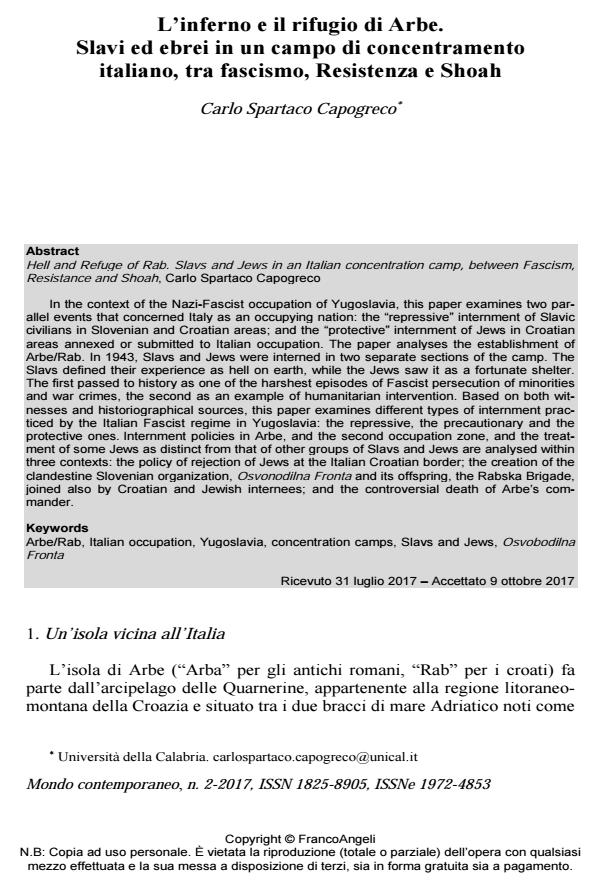L’inferno e il rifugio di Arbe. Slavi ed ebrei in un campo di concentramento italiano, tra fascismo, Resistenza e Shoah
Titolo Rivista MONDO CONTEMPORANEO
Autori/Curatori Carlo Spartaco Capogreco
Anno di pubblicazione 2017 Fascicolo 2017/2
Lingua Italiano Numero pagine 51 P. 35-85 Dimensione file 518 KB
DOI 10.3280/MON2017-002002
Il DOI è il codice a barre della proprietà intellettuale: per saperne di più
clicca qui
Qui sotto puoi vedere in anteprima la prima pagina di questo articolo.
Se questo articolo ti interessa, lo puoi acquistare (e scaricare in formato pdf) seguendo le facili indicazioni per acquistare il download credit. Acquista Download Credits per scaricare questo Articolo in formato PDF

FrancoAngeli è membro della Publishers International Linking Association, Inc (PILA)associazione indipendente e non profit per facilitare (attraverso i servizi tecnologici implementati da CrossRef.org) l’accesso degli studiosi ai contenuti digitali nelle pubblicazioni professionali e scientifiche
In the context of the Nazi-Fascist occupation of Yugoslavia, this paper examines two parallel events that concerned Italy as an occupying nation: the "repressive" internment of Slavic civilians in Slovenian and Croatian areas; and the "protective" internment of Jews in Croatian areas annexed or submitted to Italian occupation. The paper analyses the establishment of Arbe/Rab. In 1943, Slavs and Jews were interned in two separate sections of the camp. The Slavs defined their experience as hell on earth, while the Jews saw it as a fortunate shelter. The first passed to history as one of the harshest episodes of Fascist persecution of minorities and war crimes, the second as an example of humanitarian intervention. Based on both witnesses and historiographical sources, this paper examines different types of internment practiced by the Italian Fascist regime in Yugoslavia: the repressive, the precautionary and the protective ones. Internment policies in Arbe, and the second occupation zone, and the treatment of some Jews as distinct from that of other groups of Slavs and Jews are analysed within three contexts: the policy of rejection of Jews at the Italian Croatian border; the creation of the clandestine Slovenian organization, Osvonodilna Fronta and its offspring, the Rabska Brigade, joined also by Croatian and Jewish internees; and the controversial death of Arbe’s commander.
Parole chiave:Arbe/Rab, Italian occupation, Yugoslavia, concentration camps, Slavs and Jews, Osvobodilna Fronta
Carlo Spartaco Capogreco, L’inferno e il rifugio di Arbe. Slavi ed ebrei in un campo di concentramento italiano, tra fascismo, Resistenza e Shoah in "MONDO CONTEMPORANEO" 2/2017, pp 35-85, DOI: 10.3280/MON2017-002002